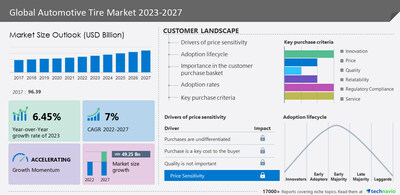NEW YORK, Dec. 1, 2023 /PRNewswire/ — The automotive tire market size is estimated to grow by USD 49.25 billion from 2022 to 2027, growing at a CAGR of 7%. APAC is estimated to account for 40% of the global market during the forecast period. Technavio’s analysts have elaborately explained the regional trends and drivers that shape the market during the forecast period. The automotive tire market in the APAC region is experiencing substantial growth, mainly due to the thriving automotive industry and the increasing demand for vehicles. Major countries in the region, such as China, Japan, South Korea, and India, are home to prominent manufacturers like Great Wall Motors, Toyota, Hyundai, and Tata Motors, making APAC a significant tire manufacturing hub. The demand for automotive tires is driven by factors like population growth, urbanization, and rising disposable income, leading to increased demand for both passenger cars and commercial vehicles. Additionally, the trend of online purchases of automotive parts and equipment is further boosting tire demand in the region. These factors collectively fuel the growth of the APAC automotive tire market during the forecast period. For Comprehensive details on the market size of historic period(2017 to 2021) and forecast period (2023-2027) – View the Sample report
Key Developments:
- Rapid advances in technology, intense competition, and changing dynamics in the market are the key factors for the intense competition among vendors.
- With the rising competition, the market will see consolidation. However, manufacturing complexities and high production costs pose significant risk factors for vendors in the market.
Market Dynamics
Major Drivers & Challenges
The rise in sales of passenger vehicles globally is a major factor driving the market growth. The global automotive tire market is growing due to the increasing sales of various passenger vehicles, such as sedans, hatchbacks, SUVs, MPVs, crossovers, and vans, which have longer lifespans, leading to continuous tire demand. The BRIC countries, including Brazil, Russia, India, and China, are key growth markets for the automotive industry due to their economic expansion and competition among global vehicle manufacturers. In the US, the average age of vehicles in use is rising, reaching a record of 12.5 years, as vehicles become more durable and well-constructed, prompting consumers to keep them for longer periods. This leads to a growing demand for automotive replacement parts, including tires, for maintenance and servicing. With vehicles being used for extended periods, regular tire replacements become essential, resulting in a higher demand for tires through both offline and online channels. As a result, the global automotive tire market is expected to witness significant growth in line with the increasing sales of passenger vehicles during the forecast period.
Environmental issues due to automotive tire manufacturing activities are significantly challenging the market growth. During the production of automotive tires, manufacturing plants release a significant amount of hazardous air pollutants, which can negatively affect local air quality and raise environmental and air pollution concerns. To address this issue, regulatory bodies have implemented regulations to limit emissions during the tire manufacturing process. These regulations will impact automotive tire manufacturers, as they will need to invest in expensive after-treatment systems and heavy machinery to ensure compliance with emission standards. For example, the US Environment Protection Agency (US EPA) has established the National Emission Standards for Hazardous Air Pollutants (NESHAP), specifically targeting tire manufacturing companies. These standards enforce emission limits for hazardous air pollutants (HAPs). Automotive tire manufacturers will need to adopt maximum achievable control technology (MACT) to control emissions of substances like methanol, styrene, formaldehyde, toluene, and hexane, which are volatile organic compounds (VOCs) known to cause various health issues. Complying with these stringent emission standards poses a significant challenge for automotive tire manufacturers during the forecast period as they strive to mitigate the environmental impact of their production processes.
Key Trends
The development of airless tires is an emerging trend shaping market growth. Non-pneumatic automotive airless tires utilize rubber treads filled with a mix of rubber and plastic and feature spokes for efficient heat distribution. However, their current limited capabilities make them most suitable for specific vehicles like ATVs, heavy industrial vehicles, golf carts, construction vehicles, and agricultural vehicles. Major tire manufacturers have been developing prototypes of airless radial tires since 2011, indicating that the advancement of these tires for automotive applications is still in its early stages. In recent years, tire manufacturers have introduced specific models of airless radial tires, demonstrating ongoing innovation in this field. For instance, Crocodile Tyres launched the 50-510-900Mk1 airless tires for heavy industrial vehicles in 2018, and Michelin partnered with General Motors to introduce their Unique Puncture-proof Tire System (Uptis) in 2019, which offers enhanced durability and reduced vulnerability to punctures compared to conventional pneumatic tires. However, airless radial tires face challenges related to operational limitations, such as heat generation and higher rolling resistance, making them primarily suitable for low-speed vehicles with a maximum speed of around 65 km/h. Tire manufacturers are actively researching alternative tire tread designs and materials to overcome these challenges. The development of these technologically advanced airless tires has the potential to drive growth in the global automotive tire market during the forecast period.
Technavio has identified key trends, drivers, and challenges in the market, which will help clients improve their strategies to stay ahead of their competitors. – View Sample Report
Vendor Landscape
The automotive tire market is fragmented; the vendors are competing with competitors and are trying to get a greater market share. The market is growing, and the chances of new entrants cannot be overlooked. The major vendors have well-established economies of scale and market presence and generally rely on positioning technological advances, and the price of the products –The report provides a full list of key vendors, their strategies, and the latest developments. Buy Now
Company Profiles
The automotive tire market report includes information on the product launches, sustainability, and prospects of leading vendors including Apollo Tyres Ltd., CEAT Ltd., Furukawa Electric Co. Ltd., Hankook Tire and Technology Co. Ltd., Hefei Wanli Tire Co., Ltd., JK Tyre and Industries Ltd., Michelin Group, MRF Ltd., Nokian Tyres Plc, Pirelli and C S.p.A, Sailun Group, Salsons Impex Pvt. Ltd., Schaeffler AG, Shandong Linglong Tyre Co. Ltd., Sumitomo Rubber Industries Ltd., The Goodyear Tire and Rubber Co., Toyo Tire Corp., Triangle Tyres, Zhongce Rubber Group Co. Ltd., and Bridgestone Corp.
Competitive Analysis
The report includes competitive analysis, a proprietary tool to analyze and evaluate the position of companies based on their industry position score and market performance score. The competitive scenario categorizes companies based on various performance indicators. Some of the factors considered include the financial performance of companies over the past few years, growth strategies, product innovations, new product launches, investments, and growth in market share, among others.
Market Segmentation
This report extensively covers market segmentation by distribution channel (OEM and aftermarket), vehicle type (passenger vehicle, commercial vehicle, and electric vehicle), and geography( APAC, North America, Europe, South America, and the Middle East and Africa).
- The OEM segments are estimated to witness significant growth during the forecast period. The OEM segment of the global automotive tire market is significantly influenced by the tires provided by original equipment manufacturers during vehicle production. The growth of the automotive industry, particularly in vehicle production, plays a key role in driving the OEM segment. OEMs prioritize offering high-quality tires that complement the features and handling capabilities of their vehicles. This segment holds a substantial share of the global market, mainly due to the presence of two-wheelers with extended tire replacement cycles. Manufacturers prefer equipping motorcycles and scooters with durable tires to balance production and procurement costs and maintain competitive pricing. As two-wheelers are commonly used as cost-effective personal transportation options, OEMs often consider cost-cutting measures when selecting tires. Many two-wheeler tires are used beyond their recommended replacement period, resulting in longer replacement cycles. Therefore, the OEM segment plays a crucial role in driving the growth of the global automotive tire market during the forecast period.
Gain instant access to 17,000+ market research reports.
Technavio’s SUBSCRIPTION platform
Related Reports:
The automotive tires e-retailing market size is estimated to grow at a CAGR of 15.3% between 2022 and 2027. The market size is forecast to increase by USD 10,797.53 million.
The automotive premium tires market share is expected to increase to USD 33.72 billion from 2021 to 2026, and the market’s growth momentum will accelerate at a CAGR of 10.58%.
TOC
- Executive Summary
- Market Landscape
- Market Sizing
- Historic Market Size
- Five Forces Analysis
- Market Segmentation by Distributional Channel
- market Segmentation by Vehicle Type
- Customer Landscape
- Geographic Landscape
- Drivers, Challenges, and Trends
- Company Landscape
- Company Analysis
- Appendix
About Us
Technavio is a leading global technology research and advisory company. Their research and analysis focus on emerging market trends and provides actionable insights to help businesses identify market opportunities and develop effective strategies to optimize their market positions. With over 500 specialized analysts, Technavio’s report library consists of more than 17,000 reports and counting, covering 800 technologies, spanning across 50 countries. Their client base consists of enterprises of all sizes, including more than 100 Fortune 500 companies. This growing client base relies on Technavio’s comprehensive coverage, extensive research, and actionable market insights to identify opportunities in existing and potential markets and assess their competitive positions within changing market scenarios.
Contact
Technavio Research
Jesse Maida
Media & Marketing Executive
US: +1 844 364 1100
UK: +44 203 893 3200
Email: [email protected]
Website: www.technavio.com
![]() View original content to download multimedia:https://www.prnewswire.com/news-releases/automotive-tire-market-size-to-grow-by-usd-49-25-billion-from-2022-to-2027apac-is-estimated-to-account-for-40-of-the-global-market—technavio-302002657.html
View original content to download multimedia:https://www.prnewswire.com/news-releases/automotive-tire-market-size-to-grow-by-usd-49-25-billion-from-2022-to-2027apac-is-estimated-to-account-for-40-of-the-global-market—technavio-302002657.html
SOURCE Technavio

Featured image: DepositPhotos © Murrstock

















